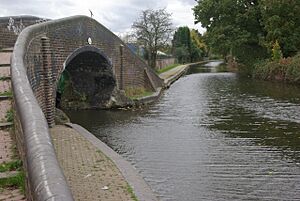Stoke Heath, Coventry facts for kids
Stoke Heath is a neighbourhood in Coventry, England. It's about 1.6 kilometres (1 mile) northeast of the city centre. Stoke Heath is surrounded by other areas like Courthouse Green to the north, Wyken to the east, Foleshill to the west, and Stoke to the south. The A444 forms its western edge.
Contents
A Look Back: Stoke Heath's History
Stoke Heath was mostly open land and fields for grazing animals until the late 1600s. It was part of bigger estates called Wyken and Caludon.
In 1604, Princess Elizabeth visited Coventry. The city leaders met her at a place called "Jabet's Ash on Stoke-green."
How Stoke Heath Grew
Stoke Heath became its own official area in 1920. It joined Coventry in 1928, which made Coventry's population grow a lot. Before this, people sometimes called the area 'Wyken Heath' or 'Wyken Knob'.
In the early 1800s, people dug for clay and sand here to make bricks near the Coventry Canal. But the biggest change happened around World War I (1914-1918).
The area was built up between 1900 and 1920. Many homes were needed for workers who made supplies for the war. During the First World War, many people from Belgium, who had to leave their homes, found a safe place in Stoke Heath.
A big part of the community was the Stoke Heath Junior & Infants School, built in 1915. It was the main focus for the first 689 homes built here. The school was rebuilt in the 1990s. The local church, St Albans, was built in 1929.
Nature and Changes
When Stoke Heath was first planned, many elm trees lined the streets. Sadly, these trees were lost to Dutch elm disease in the late 1970s. But you can still see hints of the area's green past in street names like Blackberry Lane and Valley Road.
Work and War
For many years, the Morris Motors factory was a major employer. It made car engines and later supplies for World War II. The factory closed in the 1980s and was replaced by new homes.
Because it was close to factories, Stoke Heath was heavily bombed during the Coventry Blitz in November 1940. Many people lost their lives here. The very last bombs to fall on Coventry in the Second World War also hit Stoke Heath in 1942.
Modern Stoke Heath
A part of the area, once known as "HMV" (Hillside, Meadway, Valley Road), was rebuilt between 2003 and 2004. This area is now called "Liberty Park." While some parts of Stoke Heath have families with lower incomes, there are also many homes for people with moderate incomes.
Green Spaces
Stoke Heath has two large green areas called commons: Stoke Heath Common and Barras Heath. Stoke Heath Common was once a popular place for sports, with many soccer fields. In the 1920s, it became a 'war memorial park' with plaques for fallen soldiers. Now, both commons are used for general fun activities. A memorial was put up in 1933 to remember those who protected these commons from being built on.
There's a place for canal boats on the Coventry Canal in Swan Lane. The A444 main road, improved in 2000, makes it much faster to travel between Stoke Heath and the city centre. The area also has a popular community centre.
Barras Heath and Courthouse Green Areas
Some people living near Barras Heath Common might call their area 'Barras Heath'. This area has a petrol station and a tall building called 'Alpha House'. A large wholesale market used to be here.
At the other end of Stoke Heath, near Blackberry Lane, people sometimes use the name Courthouse Green, which is a neighbouring area, to describe parts of Stoke Heath.
Alpha House is a 17-story building built in 1962. It was one of the first buildings to use a special construction method where floors were built on the ground and then lifted up.
Learning in Stoke Heath
- Stoke Heath Primary School
- Stoke Park School
Arts and Fun
Stoke Heath is home to a small amateur theatre group called The Wheatsheaf Players Co-Operative Theatre. They put on plays in Watersmeet Road.
Famous People From Stoke Heath
- Music producer Pete Waterman was born on Burlington Road.
- Terry Hall, a singer from the band The Specials, also lived in the area.


